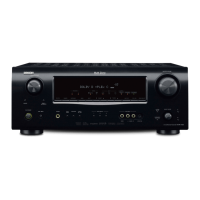ENGLISH
)
)
(
Step
2 :
Measurement
After completing a measurement position, move the microphone to
the next position.
Measure
at
6 positions: the main listening position
and
5 other
surrounding positions. Although it
is
allowable to measure less than 6
positions, it
is
recommended to measure 6 for best results.
20
• Analysis takes several minutes to complete.
•
The
time required for this analysis depends
on
the number of
speakers connected.
The
greater the number of speakers connected,
the longer analysis will take.
-Nln-
Do
not change the speaker connections
or
subwoofer volume after
"Step 1".
G)
Press
\l
to select "2nd Start<", then press
<I.
•
The
measurement of the
2nd
position starts.
C1l
Move the microphone to the 3rd position
and
press
<I.
• The measurement of the
3rd
position starts.
(]
Perform
C1l
repeatedly.
• "Calculate<"
is
displayed when you have completed
measurements
in
6 positions.
• If you want to stop after measuring just five or fewer positions,
use
\l
to display "Calculate<".
The
values obtained from the measurements
are
automatically
analyzed
and
the attributes for
each
of the speakers
in
the listening
area
are determined.
G)
Press
<I
while "Calculate"
is
displayed.
• "Calculating"
is
displayed
and
analysis begins.
(
Step
3 : Calculation
-nln-
Do
not change the speaker connections or subwoofer volume,
or
speaker locations after making measurements. If changes
are
necessary, make the changes
and
use the Audyssey MultEO auto
setup once
again
for
an
updated
EO
solution.
)
If
an
error message appears during the measurements, check "Error
Messages", take the advised action, then start the measurements
again
(~page
21).
Subwoofer
Yes:
".1 ",
No:
"0"
Number of surround speakers
or
surround
back
speakers
Number of front speakers
or
center speakers
•
To
cancel the measurements, press
<I
while"
Measure:FL <CeI"
is
displayed (''ecl'' stands for "Cancel").
About
the
Auto
Setup
The
Audyssey MultEO auto setup function detects the presence of
each
speaker
and
automatically calculates the speaker
size,
channel
level, distance,
and
optimal crossover frequency setting. Audyssey
MultEO corrects acoustical distortions within the listening
area.
Before starting, connect
and
position
all
of your speakers.
Once started, MultEO will playa series of test tones through
each
speaker.
The
speaker connection
and
polarity
are
detected
at
the first
measurement position
(main
listening position).
The
following
attributes
are
also determined at this time: "Speaker Size", "Speaker
Distance", "Channel Level", "Crossover Frequency".
G)
Press
<I
while "Auto Set<Start"
is
displayed.
• While the measurements
are
being conducted "Measure:FL
<CeI" ("FL" indicates the speaker being measured)
is
displayed.
• When the measurements
are
completed, "Sp Detect Check"
is
displayed
Press
ENTER
to display the number of speakers detected.
Example:
For
a
7.1
channel speaker configuration
• If the result differs from the actual connection status or
an
error
message appears,
use
\l
to
display"
Retry<"
and
then press
<I
to
repeat the measurement.
•
If
the result still differs from the actual connection status after
re-measurement
or
the error message still appears, it
is
possible
that the speakers
are
not connected properly. Turn the
AVR-1709
off, check the speaker connections
and
repeat the measurement
process from the beginning.
(
Step
1 :
Speaker
Detection
)
)
)
)
}
t
•
Auto
Setup
the
settings found at this stage are applied automatically.
[Auto setup flow]
( Step
3:
Calculation
( Step
2:
Measurement
( Step
1:
Speaker Detection
( Step
5:
Store
( Step
4:
Check
Auto Setup
Optimize settings for speakers
In
use
-NIU-
•
Do
not disconnect the setup microphone until the auto setup
procedure
is
completed.
• When using headphones, unplug the headphones before starting
the auto setup procedure.
-Nln-
• Loud test sounds may
be
played during Audyssey MultEO automatic
speaker setup. This
is
part of normal operation. If there
is
background
noise
in
room, these test signals will increase
in
volume.
•
Do
not stand between the speakers
and
setup microphone or allow
obstacles
in
the path while the measurements
are
being made. This
will cause inaccurate readings.
• Make the room
as
quiet
as
possible. Background noise
can
disrupt
the room measurements. Close windows, silence cell phones,
televisions,
radios,
air
conditioners, fluorescent lights, home
appliances, light dimmers, or other devices
as
measurements may
be
affected
by
these sounds.
Cell
phones should
be
placed away from
all
audio electronics during
the measurement process
as
Radio
Frequency Interference
(RFI)
may cause measurement disruptions
(even
if the cell phone
is
not
in
use)
.
• Operating
MASTER
VOLUME
during the measurements will cancel
the measurements

